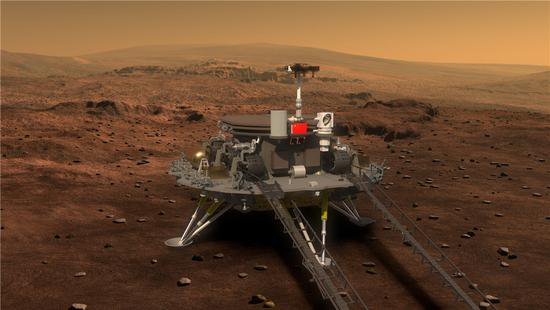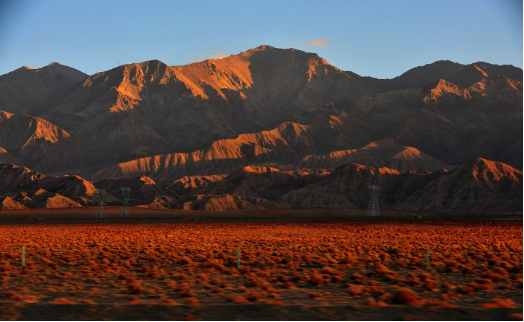By Tom McGregor, CCTV.com Panview commentator and editor
When science-fiction literature exploded in popularity during the first half of the 20th Century, Mars was routinely featured. Sci-fi authors composed tales of so-called Martian aliens invading Earth to colonize humans.
Yet, Mars is a desolate planet, devoid of living creatures, which are capable of creating spaceships that can journey into outer space. Nonetheless, scientists remain mesmerized with the red planet.
The United States and Russia were the first two countries to enter the space race and have endeavored in recent decades to launch satellites and rover missions that have already reached Mars.
The China National Space Administration (CNSA) announced a goal for its team to launch a Mars Rover by 2020 with an expected landing date to the planet by 2021.
Going above and beyond
Other Asian nations have gone before Beijing — South Korea and India have already had independent space exploration teams.
"Although we are not the first Asian nation to send a probe to Mars," MarsfortheMany Website quotes Ye Peijian, an academic at the Chinese Academy of Science (CAS), as saying. "We want to start at a higher level."
China's Mars probe could be prepared for liftoff on July or August 2020, traversing 54.6 million kilometers (33.9 million miles) - and taking an estimated 500 days to reach the planet.
The probe will contain three elements: orbiter, lander and rover. The orbiter would conduct surveys of Mars, while a lander would deliver the Rover to the planet.

(Picture of designed lander and rover issued in August, 2016 by Lunar Exploration Program and Space Engineering Center under the State administration of Science, Technology and Industry for National Defence)
The CNSA will guide the orbiting exploration and roving probe from the China's Space Command Center in Taiyuan, Shanxi Province.
The Chinese Academy of Science and Technologies (CAST) had produced a 3D video to highlight details of the highly-anticipated 10-month mission.
Reasons to explore
"The best and most direct method to look for evidence of life on Mars is to explore the surface,” said Zheng Yongchun, associate researcher at the National Astronomical Observatory (NAO). "Mars will be a key focus of China's deep space exploration in the future."
Beijing supports space exploration, since Chinese scientists recognize the value of conducting experiments in outer space, while also developing new technologies that would benefit civilians and the military.
Setting forth on a Mars mission would usher in more advances and boost research and development (R&D) in the fields of aerospace, geology, meteorology and new energy, according to Liu Xiaoqun, director of the Lunar and Deepspace Exploration Department at CAS.
Beijing issued a White Paper in 2016 to outline China's aim to become a space power by 2030.
Opening up Mars Village
Prepping for the Mars Mission, China has selected a remote site in northwest China's Qinghai Province to construct a 'Simulated Mars Station,' which will also be used for training astronauts, research lab and tourist scene.
Three-quarters of Qinghai is covered by the Gobi Desert, while the rest of the province has mountains, grasslands, rivers and lakes.
The 'Simulated Mars Station' would stand ideally located in the Qaidam Basin, a hyper-arid region with land and air conditions that resemble Mars' surface. The climate is cold, windy and dry.
Most importantly, the spot remains sparsely-populated and isolated. Astronauts must survive functioning inside a spaceship for over 500 days just to travel from Earth to Mars.
only candidates with good health and a strong mental capacity to endure deep psychological strain for lengthy periods of time can succeed.
Space tourism on earth
For China to recruit future astronauts, CNSA will play a pivotal role to promote space exploration that appeals to young Chinese.
The Chinese media has highlighted the country’s success on recent missions to space, such as the Chang'e 3 rover landing on the moon, but the Chinese youth need more hands-on experience to appreciate deep space missions.
The Mars Village, built in Dachaidan Hongya region of Haixi Mongolian and Tibetan autonomous prefecture, will not only be a training ground for astronauts and research lab, but another part will be opened up for tourists.

(Scenery of the surroundings where the Mars Village locates Photo from Internet)
The Mars simulation site would infer that tourists can find out what life on Mars is really like, such as experiencing weightlessness, they could walk and run in arid and desert terrain, feeling the harsh winds and learn so much more.
Wang Jingzhai, deputy Party chief of the prefecture, believes Mars Village can boost tourism and jumpstart the regional economy.
Inspiring tomorrow's astronauts
China has a long way to go before becoming a space power. many Chinese scientists are eager to join the ranks of researchers and developers in the deep space program, but the country needs more courageous individuals to serve as astronauts.
The life of an astronaut is not easy, especially those who may go on a mission to Mars or perhaps Jupiter. The journey will require years, not months, to reach destination points.
Imagine yourself trapped in a spaceship for such a long time. Could you survive with your health and sanity in tact? Not likely, but with specialized training, good health and the right spirit, a few members of today's youth generation could be China's next astronauts of tomorrow.
If its mission successful, they will rise to heroic status for the country and deservedly so.







